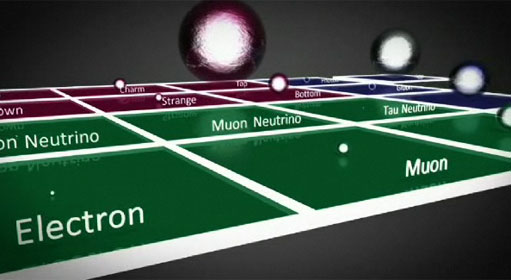
ATLAS e-News
23 February 2011
Multimedia Contest winner announced
7 September 2009

Visualising the Standard Model, from the winning entry
Back in May, ATLAS e-News reported on a new initiative designed to discover the work of the ATLAS collaboration through the eyes of creative young filmmakers: the ATLAS Multimedia Contest. Last month, 50 ATLAS scientists and students cast their votes on the entrants’ short multimedia submissions about the ATLAS Experiment.
The winner is now announced as Phil Owen, a final-year multimedia student at Monash University in Australia. His entry, The Origin of Mass, has earned him the chance to come to CERN as an intern when the LHC re-starts in November. He will spend three months taking in the spectacle as an outsider, and produce a second multimedia piece in response to his experience of the start-up.
“The overall quality of the entries was really very good. It was above our expectations … we were really touched by the amount of time people had clearly put in,” says contest co-organiser, Claudia Marcelloni.
In fact, there was a tie-break situation between the top three voted entries. In the end, the competition panel selected Phil as the overall winner and best candidate for the internship on the basis of his experience and portfolio. “It was a very tough decision,” remembers Claudia, “but Phil had the combination we were looking for: a good video piece and the right profile.”
Phil will arrive at CERN shortly after completing his degree. His submission tackled the Higgs mechanism and the Standard Model, using an exceptionally clear narration and clean, clinical 2D and 3D graphics to illustrate the points.
According to Phil, the contest caught his eye because it blended perfectly his multimedia education and his “personal fascination with the operations at CERN”. Having followed the LHC project passionately up until this point, he says he cannot wait to be here for the start-up and to meet the scientists and engineers making it happen.
“I just could not miss the chance to be involved with such a significant event,” he enthuses, adding, “I would like to help get the public as excited as I am about the future discoveries at CERN.”
Movie-set designer Jonathan Bowden from Los Angeles, USA, submitted the second place entry – a surreal cartoon car-chase through the LHC tunnel, taking in the Standard Model, superstrings and sandwiches, amongst other things. Third place went to Simon Howells, a digital animation Masters student from the UK, who used original 3D animation to create a beautifully semi-abstract symphony of detector pieces falling into place in the ATLAS cavern, with a proton-proton collision at the climax.
Stills from the top six of the thirteen entries can be viewed in our Photo Gallery this week, while the videos, which were all awarded prizes, are available to watch on our outreach site. Please keep in mind that the competition was aimed at multimedia artists, and make allowances for the physics being slightly off-kilter at times.

Ceri PerkinsATLAS e-News
|